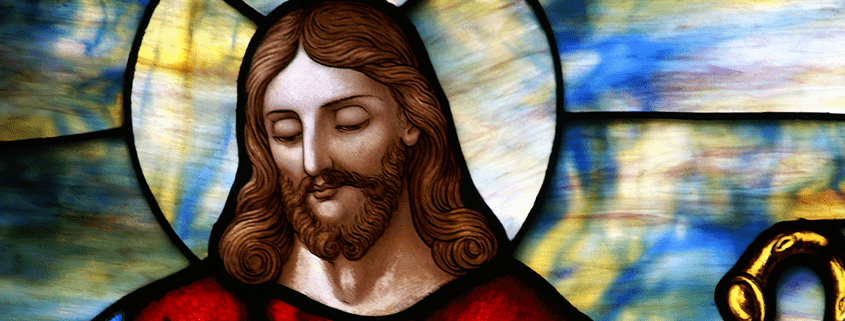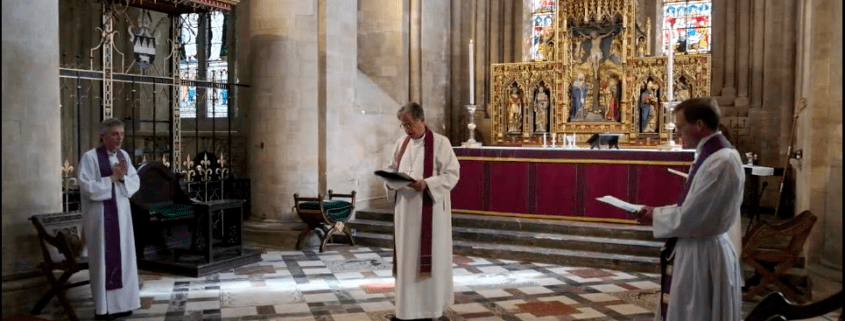The Venerable Judy French, Archdeacon of Dorchester, gave the following sermon during our Church at Home online service on Sunday 26 April: A Reflection for Easter 4 Acts 2:42-end; Psalm 23; John 10:1-10
Today is unofficially known as ‘Good Shepherd Sunday’ in the Church’s calendar, because on this 4th Sunday of Eastertide there is always a reading from part of John’s Gospel Chapter 10, in which Christ says, ‘I am the Good Shepherd’. It’s a very well-known and well-loved picture of Jesus, and brings to mind someone who will guard and protect us, care for us and know us each by name, who will lead us to good pasture and back home again to safety, who will come looking for us when we are lost. And that’s reinforced by the words of Psalm 23, which we’ve being praying together every day during the lockdown – the Lord is my Shepherd, he shall refresh my soul. It’s an image woven into the biblical story of God’s relationship with his people, as shepherd and flock.
In today’s Gospel, Jesus tells a little story about a sheepfold and explains the difference between those who hop over the wall to do a bit of sheep-stealing, and the one who enters by the gate and knows every sheep by name. One lot are thieves and bandits and absolutely not to be trusted, and the other is the shepherd who can be trusted to look after the sheep. So far, so good. The message is that we have to listen to the voice of the shepherd who will look after us, and not the thief who wants either to kill and eat us or sell us at the market for his own profit. Make of that what you can. Jesus first focuses attention on the relationship between the shepherd and the sheep, because that is fundamental to what follows; it is crucial for the life and well-being of the sheep, and indicative of what Jesus will do for them, ultimately. But even given the familiarity of the image for his hearers, they don’t understand what he’s talking about or why it’s relevant.
And then just as we are expecting Jesus to say he is the Good Shepherd, which brings to mind all sorts of traditional childhood pictures, he says instead, ‘I am the gate for the sheep’. A gate is not a very rosy or sentimental image. It is practical. It is the shepherd, lying across the entrance to the sheepfold, to guard and protect. It is a way in and a way out; it enables a keeping together in one place and separating, the sheep inside from the dangers outside. Jesus said, ’I am the gate. Whoever enters by me will be saved, and will come in and go out and find pasture. The thief comes only to steal and kill and destroy. I came that they may have life, and have it abundantly.’ And there’s the point of the story: it’s not about security, it’s about abundant life.
It’s particularly poignant in our current context when our coming in and going out is restricted, and what we do and where we go has the potential to affect the life and health of others. This is life, but not as we know it. In a very short space of time, we are having to learn new ways of living and worshipping and working. We may have mixed feelings about the lifting of restrictions: a longing for the freedom of movement we once had; some loss of confidence about our safety and that of those we love if we go out; anxiety about the economy, businesses, and livelihoods; a fresh emerging vision of doing things differently as we emerge from this, particularly in terms of family life, working patterns, church life, the climate emergency. Both during the lockdown and as we emerge from it, we are first disciples of Jesus; we come and go and engage with the world around us, whether at home or in our communities, through listening to the voice of the shepherd, the one who leads us and offers abundant life.
In John’s Gospel, the story of the sheepfold is told in the context of Jesus healing the man born blind, which takes up the whole of the previous chapter. By the end of that story, the man is thrown out of the synagogue by the religious leaders who don’t accept that Jesus is from God. But the man who now sees, recognises and believes in Jesus, and becomes his disciple. Jesus follows that life-changing encounter with the story of the sheepfold and contrasts exclusion and inclusion, death and life. We read this story in the light of Easter and resurrection, and it is significant too that what follows is the raising of Lazarus and Jesus’ own journey to the cross, as the shepherd gives his life for the sheep. ‘I have come that they may have life, and have it abundantly.’
Over the last six weeks or so, our homes have become not only places of home-schooling, work, and family life, but also very intentionally places of prayer and worship. Church at Home, church online, our own times of prayer and reflection, have become ways in which we are focussing, probably more than we did before, on listening to the voice of the shepherd. Doing and being church online is so new for many of us, and as our online presence grows, we are beginning to ask what ‘church’ will look like when the lockdown lifts, and we can return to our church buildings. What’s the exit strategy? We don’t yet know what that looks like for the country or for the church. What will be the ‘new normal’? How do we go forward with a ‘mixed-mode’ church? How do we grow our regular congregations alongside our new online worshipping communities? There is a sense that God is doing something new, and that is exciting, but it’s also unsettling because we don’t know what the future looks like; we are out of our comfort zones. It feels like we really are putting out into deep water, to use another metaphor. If we take our cue from the Gospel today, we will best meet whatever comes next by keeping on listening for the shepherd’s voice, keep returning to the one we trust, who knows us by name and leads us, the Lord who is our Shepherd, who restores and refreshes our souls.
Amen.


